
Ethiopian Cross and Antique Treasures: A Unique Collection
A Coptic Ethiopian cast bronze cross, five antique tortoiseshell napkin rings, an antique mother of pearl and papier mache snuff box, a Viennese hand painted glass powder box, a pottery plaque of seated figure, a bone dice and a 'Baby' (part) brooch, (12…
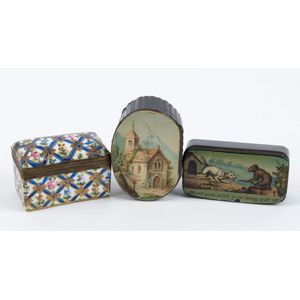
Antique Snuff and Thimble Boxes Plus Porcelain Casket
Three snuff and thimble boxes, two papier-mache with transfer printed lids, plus a Sevres porcelain miniature casket, circa 1870, the largest 4 cm high, 6 cm wide

19th Century Painted Papier Mache Snuff Box
A papier mache snuff box with painted lid, 19th century, the rectangular snuff box, painted to the hinged lid with a noble lady on horseback, unmarked. Height 2 cm, length 6 cm, width 3 cm
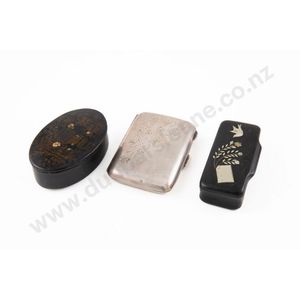
Sterling Silver Cig Case with Papier Mache Snuff Boxes
George V sterling silver Cig case slightly bowed with engraved shamrocks and Irish winged Hibernia/harp figure, Birmingham 1924, together with a Victorian rectangular papier mache snuff box with inlaid lid and an oval example with Chinoiserie decorated lid

19th Century Shoe Snuff Boxes
Two 19th century shoe snuff boxes, one carved wood with sliding lid and brass tacks to the sole 'Emma'. The other finely detailed, of black lacquered papier mache.

Victorian Snuff Boxes Set
Three Victorian snuff boxes comprising, a larger burr walnut, smaller burr walnut example and small inlaid papier mache box
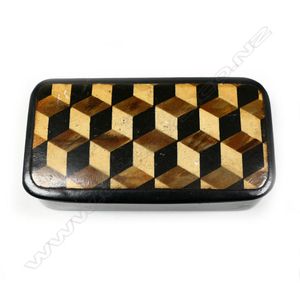
Victorian Tumbling Box Snuff Box
A Victorian papier mache snuff box, the lid decorated in the tumbling box pattern, length 7.5 cm.
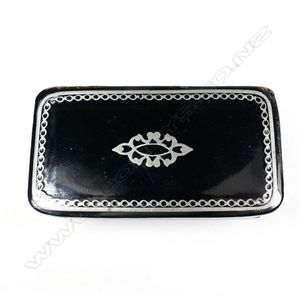
Victorian Silver-Bordered Papier Mache Snuff Box
A Victorian papier mache snuff box, rectangular form, the lid decorated with silver border and central medallion, length 8.5 cm.
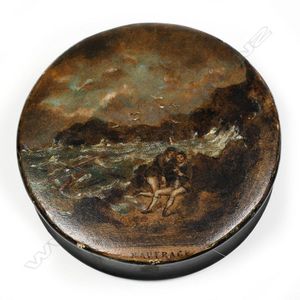
Georgian Shipwreck Survivors Papier Mache Snuff Box
A Georgian papier mache snuff box, round form, the lid painted with survivors of a shipwreck. Diameter 7.5 cm.
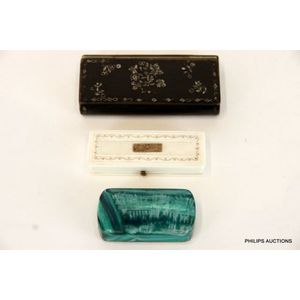
Georgian Snuff Boxes and Miniature Gold Ivory Box
Two Georgian papier mache snuff boxes and a miniature gold inlaid ivory box, early 19th century, a black lacquered box with delicate silver inlaid borders and floral forms, and a smaller rounded edge box with either contemporary or later faux malachite…
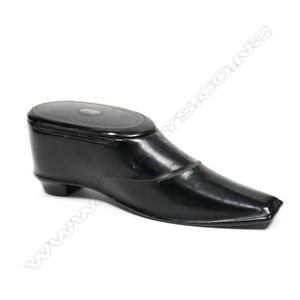
Antique Boot-Shaped Snuff Box with Cut Steel Embellishments
A 19th century papier-mache snuff box, in the form of a boot with a high polish finish, cut steel embellishments. Length 10 cm.
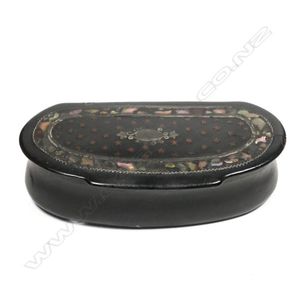
Mother-of-Pearl Inlaid Snuff Box
A 19th century papier-mache snuff box, curved front, the lid decorated with inlaid mother-of-pearl and steel decoration. Length 9 cm.
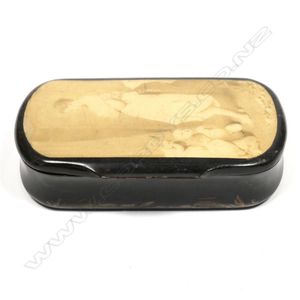
19th Century Woman and Cherub Snuff Box
A 19th century papier-mache snuff box, rectangular form, the lid decorated with a woman glaring at penitent cherubs. Length 9.5 cm.
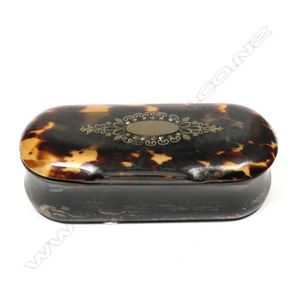
19th Century Tortoiseshell Inlaid Snuff Box
A 19th century papier-mache snuff box, rectangular form, the lid in tortoiseshell with inlaid brass decoration. Length 8 cm.

19th Century Skittles Snuff Box
A 19th century papier-mache snuff box, square form, the lid illustrated with two boys playing skittles. 8.5 x 5.5 cm.
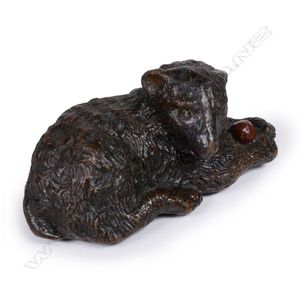
Georgian Dog-shaped Papier-Mache Snuff Box
A late Georgian papier-mache snuff box, in the shape of a dog lying down with his ball, the lid under the base. Length 12 cm.
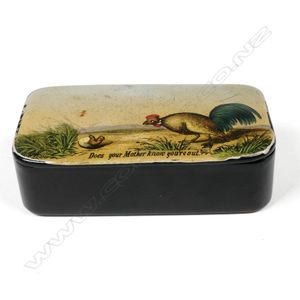
Chicken & Rooster Snuff Box with Playful Message
A 19th century papier-mache snuff box, the lid with painted decoration of a chicken and rooster, 'Does Your Mother Know You're Out'. 7.5 x 4 cm.
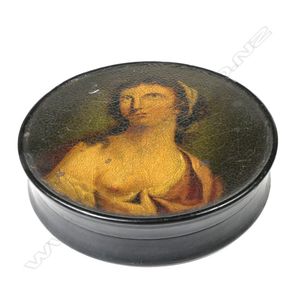
19th Century Papier-Mache Snuff Box with Scantily Clad Woman Portrait
A 19th century papier-mache snuff box, the lid with painted portrait of a scantily clad young woman, signed and inscribed on the underside of the lid, 'S Raven Pinxt. Patronized by HRH the Duke of Sussex & Prince Leopold of Saxe-Coburg'. Diameter 10 cm.
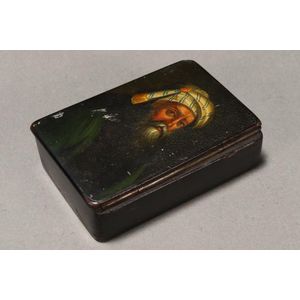
Georgian Portrait Snuff Box
Georgian papier mache snuff box and cover, of rectangular form, painted with a portrait of a man, length 8 cm
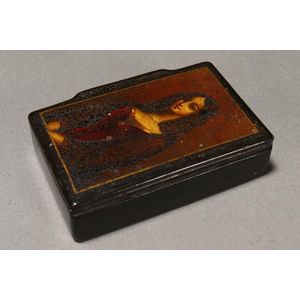
Georgian Lady Papier Mache Snuff Box
Georgian papier mache snuff box and cover, of rectangular form, painted with an image of a seated lady, length 9 cm
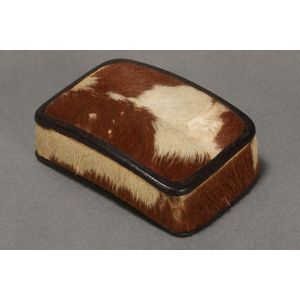
Georgian Pony Hair Snuff Box with Silver Monogram
Unusual Georgian snuff box and cover, of curved rectangular form, in papier mache, covered in pony hair set with silver monogram, length 7.5 cm
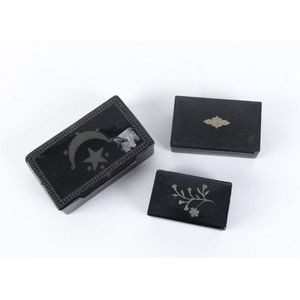
18th Century Ottoman and English Snuff Boxes
Three snuff boxes, black papier mache with inlaid silver, English and ottoman Empire, 18th century, the largest 8.5 cm wide
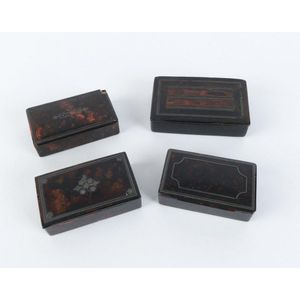
Georgian Snuff Boxes with Silver Inlay
Four Georgian snuff boxes, papier mache with faux tortoiseshell finish and silver inlay, 18th century, the largest 9 cm wide
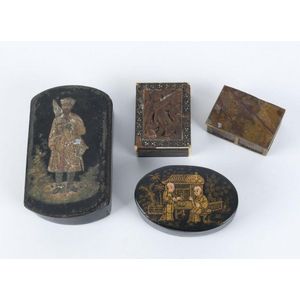
18th Century Snuff Boxes (4)
Two Chinoiserie papier mache snuff boxes, an Anglo-Indian snuff box and a French agate and ormolu snuff box, 18th century, (4 items), the largest 10.5 cm wide
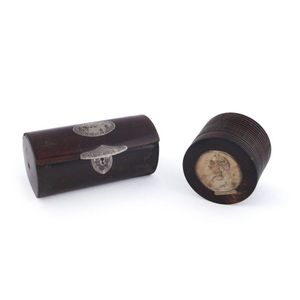
Antique Snuff Boxes with Royal and Silver Accents
Two antique snuff boxes, one circular treen ware with lithograph portrait of King George III, the other papier mache with silver lock and plaque, 18th century, the larger 7.5 cm wide
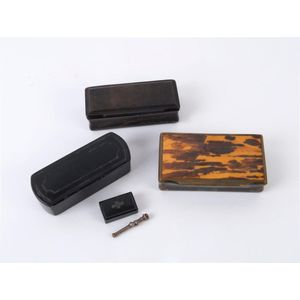
18th Century Snuff Boxes: Papier Mache and Horn & Tortoiseshell
Three snuff boxes, two black papier mache and one horn and tortoiseshell, 18th century, the largest 10 cm wide
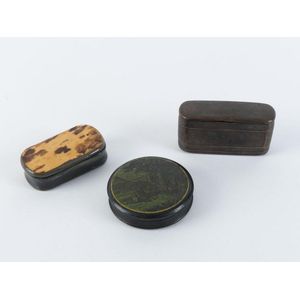
Georgian Snuff Boxes: Papier Mache and Tortoiseshell
Three Georgian snuff boxes, papier mache and tortoiseshell, late 18th early 19th century, the largest 9 cm across

Tortoise Shell Papier Mache Snuff Box
Papier mache snuff box, of rounded rectangular form, decorated with tortoisehell motif, length 7 cm

Georgian Hand-Painted Snuff Box with Hunting Scene
Georgian hand painted papier mache snuff box and cover, of rectangular form, painted with a scene of figures and hunting dogs, length 8.5 cm
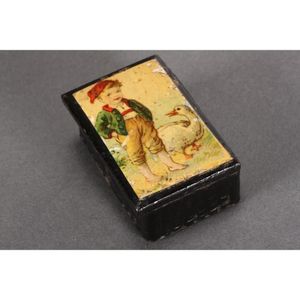
Victorian Papier Mache Snuff Box with Boy and Duck Scene
Late Victorian papier mache snuff box and cover, of rectangular form, decorated with scene of a young boy and duck, length 5 cm
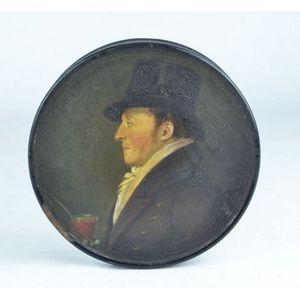
19th Century Painted Snuff Box with Gentleman Portrait
19th century papier mache circular snuff box with painted image of a gentleman with hat Af, diameter:10 cm
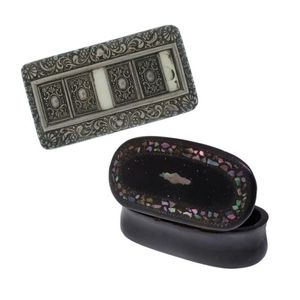
Victorian Sterling Silver Card Tracker & Snuff Box Set
Victorian hallmarked sterling silver card suit Tracker. Together with a papier mache snuff box, length 8 cm (tracker)

Georgian Snuff Boxes, Early 19th Century
Four Georgian snuff boxes, papier mache, horn and timber, early 19th century, the largest 8.5 cm across
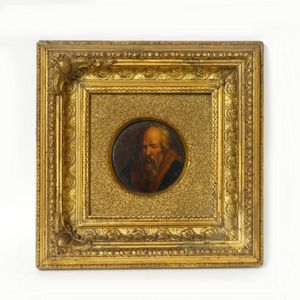
Georgian Snuff Box Lid with Portrait of Elderly Gentleman
A Georgian painted papier mache snuff box lid, in 19th century gilt frame, a portrait of an elderly gentleman. Overall 25 cm x 25 cm.
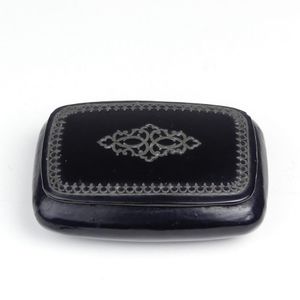
Georgian Metal Inlay Snuff Box
A Georgian papier mache snuff box, cushion shape with cut metal inlay. Width 9.5 cm

19th Century Papier Mache Ecclesiastical Snuff Boxes
Four printed papier mache snuff boxes, 19th century, each depicting ecclesiastical scenes including the Last Supper, Madonna and Child, St Michael the arch angel, largest 9 cm, 6 cm, 2 cm
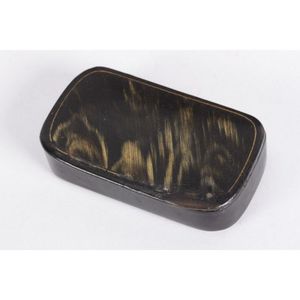
Georgian Honeycomb Snuff Box
Georgian paper mache snuff box and cover, of rectangular form, in tones of black and honeycomb, length 6.8 cm
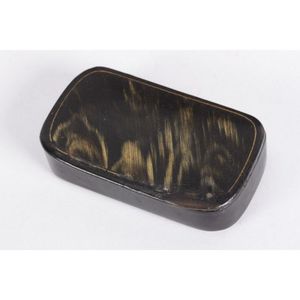
Georgian Honeycomb Snuff Box
Georgian paper mache snuff box and cover, of rectangular form, in tones of black and honeycomb, length 6.8 cm

19th Century Papier Mache Snuff Boxes with Souvenirs
Three 19th century papier mache snuff boxes, with transfer decoration to each lid and all containing little interesting souvenirs. Provenance: The Flower Family Collection.
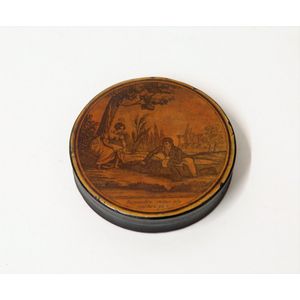
19th Century Lacquer Snuff Box with Classical Scene
An early 19th century black lacquer papier-mâche snuff box, circular, the lid with fine detailed image of a classical couple within a landscape, the seated woman lifting her dress, entitled 'Regardez mais n'y touchez pas' (Look, but do not touch).…
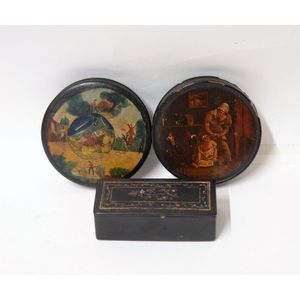
19th Century Lacquer Snuff Boxes with Painted Scenes
Three early 19th century black lacquer and papier-mâche snuff boxes, two circular with painted picture scene lids, the other rectangular
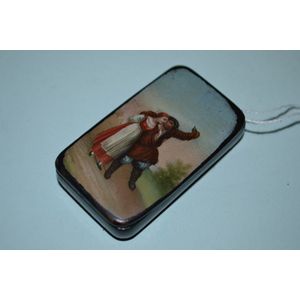
19th Century Russian Couple Snuff Box
19th century papier mache hand painted snuff box with Russian couple motif
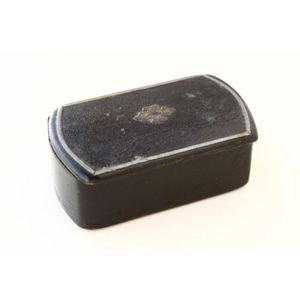
Victorian Papier Mache Snuff Box with Central Motif
Victorian papier mache snuff box and cover, of rectangular form, set with central motif, length 6.1 cm
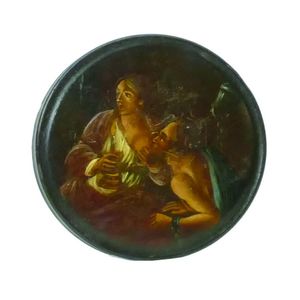
Georgian Papier Mache Snuff Box with Sir Thomas More Scene
A Georgian circular papier mache table snuff box, the lid painted with a scene of Sir Thomas More in prison, nourished by his daughter c.1535. Diameter 9 cm

German Papier Mache Snuff Box, Late 18th/Early 19th Century
A German papier mache snuff box. Late 18th / early 19th century, probably by Johann Heinrich Stobwasser. Height 2.5 cm. Width 8.5 cm. Depth 4.5 cm
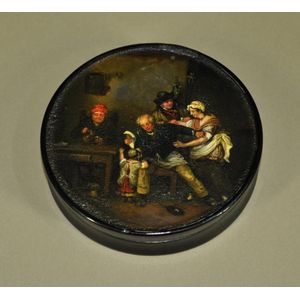
19th Century Papier Mache Snuff Box with Painted Scene
Early 19th century papier mache snuff box. Painted scene of an interior to lid. Lid inscribed underneath ' S[amuel] Raven Pinx. Patronised by HRH Duke of Sussex & Prince Leopold.' label to base for Law, Foulsham & Cole. Diameter 9.5 cm

19th Century Painted Snuff Box with Ship Design
A black papier mache and painted snuff box, 19th century, the lid painted with the ship Minotaur, 1867, 2.5 cm high, 6.5 cm long and 2.75 cm deep
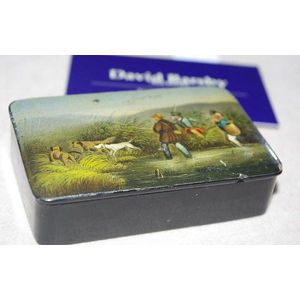
Hand-painted Hunting Scene Snuff Box
19th century papier mache snuff box handpainted with a hunting scene




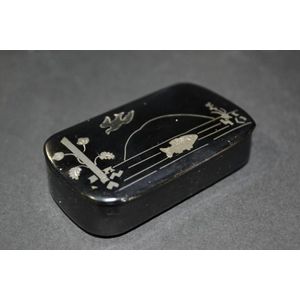

 Loading more...
Loading more...